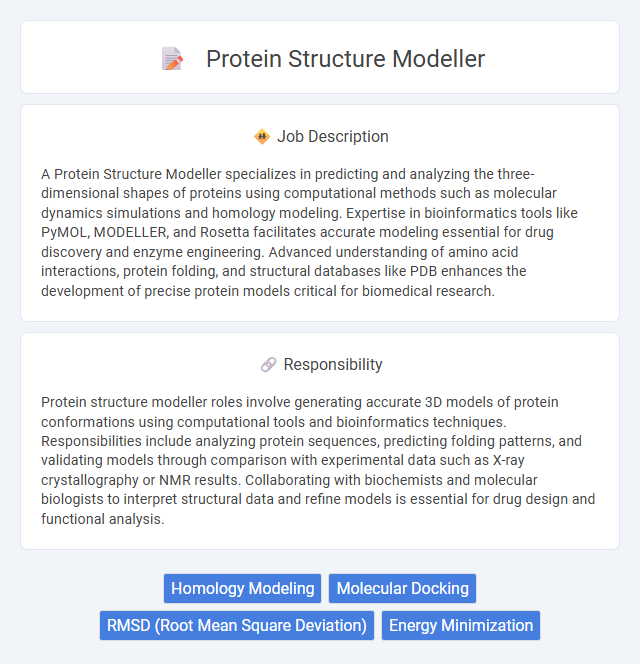
A Protein Structure Modeller specializes in predicting and analyzing the three-dimensional shapes of proteins using computational methods such as molecular dynamics simulations and homology modeling. Expertise in bioinformatics tools like PyMOL, MODELLER, and Rosetta facilitates accurate modeling essential for drug discovery and enzyme engineering. Advanced understanding of amino acid interactions, protein folding, and structural databases like PDB enhances the development of precise protein models critical for biomedical research.
Individuals with strong analytical skills and a passion for molecular biology are likely to find a protein structure modeller role suitable and fulfilling. Those comfortable working with complex software and data interpretation may have a higher probability of success in this position. People who prefer hands-on lab work or have limited experience in computational methods might find this job less aligned with their strengths.
Qualification
A Protein Structure Modeller must possess advanced expertise in computational biology, structural bioinformatics, and molecular modeling techniques. Proficiency in software tools such as PyMOL, Rosetta, and molecular dynamics simulators, combined with a strong background in biochemistry or molecular biology, is essential. A degree in bioinformatics, computational biology, or a related field, along with experience in protein folding prediction and structure validation, is highly preferred.
Responsibility
Protein structure modeller roles involve generating accurate 3D models of protein conformations using computational tools and bioinformatics techniques. Responsibilities include analyzing protein sequences, predicting folding patterns, and validating models through comparison with experimental data such as X-ray crystallography or NMR results. Collaborating with biochemists and molecular biologists to interpret structural data and refine models is essential for drug design and functional analysis.
Benefit
A Protein Structure Modeller job likely offers significant benefits including opportunities to contribute to groundbreaking biomedical research and drug discovery. Employees might gain access to cutting-edge computational tools and collaborative environments that enhance skill development. The role probably provides a competitive salary and potential for career advancement in the growing field of structural bioinformatics.
Challenge
A Protein Structure Modeller likely faces the challenge of accurately predicting complex protein folding patterns from limited experimental data, which requires integrating advanced computational methods with biological insights. The task probably involves handling large datasets and overcoming uncertainties inherent in molecular dynamics simulations. Managing these complexities effectively could determine the success of drug discovery and therapeutic design projects.
Career Advancement
A Protein Structure Modeller role offers significant opportunities for career advancement through expertise in computational biology, bioinformatics, and molecular modeling techniques. Mastery in software such as PyMOL, Rosetta, and molecular dynamics simulations enables progression to senior scientific roles, project leadership, and research management positions. Continuous development in artificial intelligence applications and structural prediction methods can lead to specialization and influential roles in pharmaceutical research and biotechnology industries.
Key Terms
Homology Modeling
Protein structure modeller roles specializing in homology modeling involve predicting the three-dimensional structure of proteins based on evolutionary relatedness to known templates. These professionals utilize bioinformatics tools like MODELLER and SWISS-MODEL to construct accurate protein models critical for drug discovery and functional analysis. Expertise in sequence alignment, molecular visualization, and protein folding principles enhances the reliability and precision of homology-based structural predictions.
Molecular Docking
Protein structure modellers specializing in molecular docking utilize computational techniques to predict the interaction between proteins and ligands, aiding drug discovery and design. Expertise in software tools like AutoDock, Glide, and Rosetta enables accurate simulation of binding affinities and conformational changes in target molecules. Mastery of protein-ligand docking accelerates identification of therapeutic candidates by elucidating molecular recognition and binding mechanisms.
RMSD (Root Mean Square Deviation)
Protein structure modellers specialize in predicting and refining 3D conformations of proteins with precise accuracy, where RMSD (Root Mean Square Deviation) serves as a critical metric for evaluating structural similarity between predicted models and experimentally determined references. Minimizing RMSD values directly correlates to improved model fidelity, essential for applications like drug design, protein engineering, and functional annotation. Expertise in computational algorithms and molecular dynamics simulations enables modellers to iteratively reduce RMSD, enhancing confidence in protein structural predictions.
Energy Minimization
Protein structure modellers use energy minimization techniques to refine 3D molecular models, ensuring the most stable and biologically relevant conformations. Energy minimization algorithms reduce steric clashes and unfavorable interactions by adjusting atomic positions to reach a local energy minimum. This process is crucial for accurate drug design, protein engineering, and molecular dynamics simulations.
 kuljobs.com
kuljobs.com